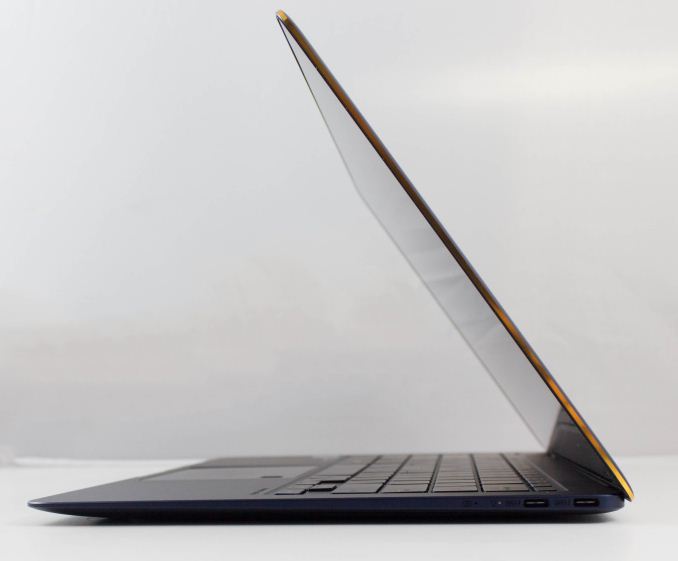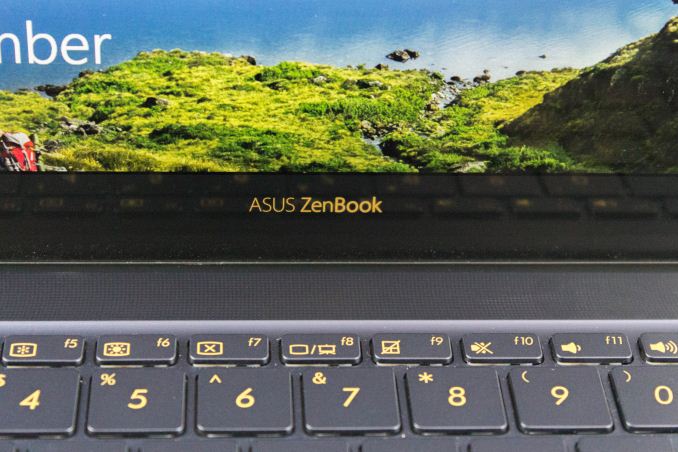The ASUS ZenBook 3 Review: A Convincing Case for Quad Core Thin & Light Laptops
by Brett Howse on November 22, 2017 8:00 AM EST- Posted in
- Laptops
- Asus
- Zenbook
- Core 8th Gen
- Kaby Lake Refresh
Final Words
We’ve been waiting for quad-core U series for some time, and we have to thank ASUS for sending us the ZenBook 3 so we could check out the latest and greatest CPU from Intel. While the 8th generation Core branding is a bit of a mess, and the delay in 10 nm chips has been disappointing, the Kaby Lake Refresh does offer a nice jump in performance over the dual-core parts from last year, but without impacting battery life, or single-threaded performance. This is definitely a win-win.
We’ve spent a lot of time discussing the performance of the Core i7-8550U, since this is our first look at it, but the ZenBook 3 certainly needs some discussion as well. ASUS offers a lot of products which are “more for less”, but the ZenBook 3 hits the premium end of the Ultrabook range. Does it deliver on the price?
The design certainly does. The all-aluminum ZenBook 3, especially in the Royal Blue of the review unit, is a striking laptop to look at. The blue with bronze trim is a great color combination, and the build quality seems like it is up there with the best laptops around. The “aerospace-grade aluminum alloy” is definitely marketing speak, but the laptop is very rigid, and hardly bends at all when you pick it up by one corner, despite it being as thin as it is. Not all thin and light laptops offer this kind of rigidity, and it adds to the premium feel ASUS has provided with their anodized texture.
ASUS, like several other PC laptop manufacturers, doesn't really put any effort into color accuracy on their devices, which is a shame. This nice notebook does leave something to be desired if you crave color accuracy at all, and as calibrated displays becoming increasingly common on premium devices, the ZenBook 3 feels oddly left out. The brightness levels are low, but it does offer good contrast ratios.
ASUS also moved to the thin bezel design that we would expect in a premium device in 2017, and the 14-inch panel is a great fit for this notebook. The resolution is not as high as some of the competition, but 1920x1080 in a 14-inch display is still sharp enough for most people. It’s hard to give up the really sharp displays once you’ve used them for a while, but the extra battery life you gain is always welcome.
Speaking of battery life, despite the small battery capacity, and a fear going into this review that battery life would be the Achilles heel of this notebook, it offers great battery life, with over eleven hours on our light test. It shouldn’t be too difficult to get through a work day, even without the charger handy. The efficiency of this notebook is one of the best we’ve seen.
The move to all USB-C ports is both a blessing and a curse. We want our devices to be forward-looking, and ASUS has delivered here with not one, but two Thunderbolt 3-enabled USB-C ports, along with a third pure USB-C port. This lets you charge the laptop from any of the USB ports, which is fantastic, but it does mean you’ll need an adapter for any USB-A devices you have kicking around. The good news is that if you do buy new cables, or an adapter, you’ll be set going forward. It can just be a pain if you are on the road and need to hook something up, since the move to USB-C has been slower than many of us would like.
The worst feature on the ZenBook 3 is the VGA webcam, which is decidedly retro on this device with Thunderbolt 3 and USB-C only. If you use the webcam a lot, or even just some of the time, you should consider another product.
There’s a lot of good things to say about the ZenBook 3, and not a lot to complain about. It offers everything you’d expect in a modern Ultrabook, and more, and it does it all in a thin, light, and well-designed package that should please almost anyone. ASUS has a solid offering at the top of their lineup, and one that offers plenty of performance. If you’re Ultrabook shopping, be sure to kick the tires on this laptop.














55 Comments
View All Comments
aeronatis - Wednesday, November 22, 2017 - link
I believe they prefer to implement LPDDR to be able to reach long battery runtime during sleep. With standart DDR, any sleeping computer is pretty much out of juice overnight whereas laptops with LPDDR can sleep for days.DanNeely - Wednesday, November 22, 2017 - link
I've been able to sleep Dell Latitudes used by my previous employer over the weekend since the 2008(?) models; AFAIK all of them used standard DDR2/3 not low power sorts.hybrid2d4x4 - Thursday, November 23, 2017 - link
Overnight? That's a pretty major exaggeration. I had a Acer 3830TG (Sandy bridge, 4GB DDR3) that lasted >3 weeks in sleep. And before anyone says it, I always "powercfg -h off" on a new system/OS install.wolrah - Wednesday, November 22, 2017 - link
@labrats5 Who said anything about LPDDR3?@Jimios basically I'm looking for a powerful, portable machine on which to run VMs and do development. It'll never run games or even Windows so an nVidia or AMD GPU is just wasted silicon, wasted power, and annoying driver problems. I'd rather just use the Intel GPU that's built in to the processor and has great Linux support, but basically every proper workstation laptop forces a Quadro on you.
If I want to avoid the GPU I'm stuck looking at the thinner models. I don't really care about thin, I think my 2008-era Macbook Pro (the one right before unibody, that was basically an evolution of the Powerbook G4 design) was perfect as far as size/weight goes.
Jimios - Wednesday, November 22, 2017 - link
Can't the dGPU be completely disabled through BIOS/EFI or something? I haven't owned a non-Apple laptop recently so I honestly don't know.As for your use case (multiple VMs, etc.), I understand, but I don't think there would be too much demand for what you're asking. A laptop with your description wouldn't sell well to justify the development and marketing cost, IMO. Laptops like the article we're commenting on are mass market devices.
Also, typically with "workstation laptops" companies aim at CAD/CAM engineers and creative professionals. Which is sad, and I understand your frustration.
DanNeely - Wednesday, November 22, 2017 - link
As a developer currently using a Yoga with 16GB of ram, while I'd rather have a big laptop with a 45W CPU and 32GB of ram; if I could only have 1 I'd go for the ram multiple VMs or copies o Visual studio and a bunch of loaded browsers max out 16GB more often than I'm CPU limited.wolrah - Wednesday, November 22, 2017 - link
"Can't the dGPU be completely disabled through BIOS/EFI or something? I haven't owned a non-Apple laptop recently so I honestly don't know."I have yet to encounter a dual-GPU laptop where all the video ports were wired through the onboard GPU. Usually at least one of the external ports and sometimes the internal display is wired through the dedicated component, requiring that part to be enabled for those ports to work.
On my current Asus with a GT650M the HDMI port is wired through the nVidia chip so if I want to use an external monitor I have to either use VGA (yuck) or deal with the disaster that is nVidia Optimus. Even under Windows it's annoying, under Linux it's a mess.
linuxgeex - Thursday, November 23, 2017 - link
I've felt the same as you for the last decade, but you'd be surprised these days. AMD GPUs are quite well supported out of the box on open drivers, within 6mo of launch, and generally you can get them up on launch day using recent kernel/Mesa releases. I'll be getting an AMD 2500u based laptop this time around. Probably the Acer Swift.timecop1818 - Thursday, November 23, 2017 - link
> basically I'm looking for a powerful, portable machine on which to run VMs and do development. It'll never run games or even Windows so an nVidia or AMD GPU is just wasted silicon, wasted power, and annoying driver problems. I'd rather just use the Intel GPU that's built in to the processor and has great Linux support, but basically every proper workstation laptop forces a Quadro on you.you had me until "never runs Windows", lol.
nice troll, bro, nice troll.
also, accelerated graphics support in lunix. ha ha ha ha ha.
thanks for the laugh.
IGTrading - Wednesday, November 22, 2017 - link
It will be lovely to watch AMD Ryzen Mobile mop the floor with this 1700 USD waste of money.For this much money, I would expect way better performance, but luckily HP Envy x360z with Ryzen Mobile is just 600 USD.
There's nothing in ASUS' new Zen that's worth the extra 1000 USD they're asking.